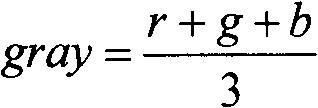Method for illuminating/normalizing image and method for identifying image by using same
An image recognition and normalization technology, applied in the field of pattern recognition, to overcome the influence of lighting factors and enhance the effectiveness
- Summary
- Abstract
- Description
- Claims
- Application Information
AI Technical Summary
Problems solved by technology
Method used
Image
Examples
Embodiment 1
[0046] The illumination normalization in this embodiment is improved on the basis of the TVQI model.
[0047] Such as figure 1 As shown, the method for performing illumination normalization processing on an image includes the following steps:
[0048] (1) Normalize the input image to a 100×100 grayscale image I
[0049] If the input image is a grayscale image, modify the image pixels to 100×100;
[0050] If the input image is a color image, the color image is converted into a grayscale image by the following formula:
[0051] gray = r + g + b 3
[0052] In the formula, r, g, and b represent the values of the red, green, and blue components in the color image, respectively, and gray represents the gray value of the grayscale image.
[0053] (2) Segment the input image into shadow areas and normal light areas
[0054] The method of d...
Embodiment 2
[0139] The illumination normalization in this embodiment is improved on the basis of the LTV model.
[0140] LTV model comes from: "Total variation models for variable lighting face recognition" Chen, Terrence; Yin, Wotao; Zhou, Xiang Sean; Comaniciu, Dorin; Huang, Thomas S. Source: IEEE Transactions on Pattern Analysis and Machine Intelligence, v 28, n 9 , p 1519-1524, September 2006.
[0141] The LTV model and the TVQI model come from the same article. The difference between the two is that TVQI uses a quotient operation, and LTV uses a logarithmic operation. Using the LTV model differs from using the TVQI model only in steps (3) and (4).
[0142] Only the differences from Embodiment 1 will be described below.
[0143] Step 3: Use the LTV model to process the normalized input image obtained in step 1 to obtain λ L1 = 0.2, the small-scale part v of the face image λ=0.2 . The specific steps are:
[0144] A. Perform logarithmic operations on the input image
[0145] f(x,...
PUM
 Login to View More
Login to View More Abstract
Description
Claims
Application Information
 Login to View More
Login to View More - R&D
- Intellectual Property
- Life Sciences
- Materials
- Tech Scout
- Unparalleled Data Quality
- Higher Quality Content
- 60% Fewer Hallucinations
Browse by: Latest US Patents, China's latest patents, Technical Efficacy Thesaurus, Application Domain, Technology Topic, Popular Technical Reports.
© 2025 PatSnap. All rights reserved.Legal|Privacy policy|Modern Slavery Act Transparency Statement|Sitemap|About US| Contact US: help@patsnap.com



